Panoramic animations offer "romantic overview" of dystopian future cities
Architect Liam Young has developed a series of animated panoramas depicting visions for cities of the future, including an urban landscape exclusively owned and operated by technology brand Samsung (+ movie).
Liam Young – whose studio Tomorrow's Thoughts Today operates between the realms of architecture, film and fiction – merged photographs taken on expeditions around the world with images sourced online to produce a vision of what he described as an "exaggerated present".
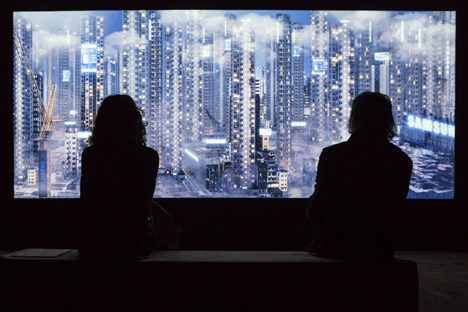
"The New City project is a demonstration of the way that I work as a speculative architect," Young told Dezeen. "I construct alternative worlds as a means to understand our own world in new ways."
The three imaginary skylines exaggerate current trends such as the proliferation of advertising and the problems associated with land fill, to give a sense of how these issues could evolve to affect the appearance of future metropolises.
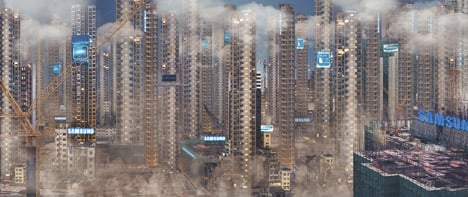
Each of the speculative cities is accompanied by a short story written by science fiction authors Jeff Noon, Tim Maughan and Pat Cadigan, which create a narrative based around the characteristics of the landscapes.
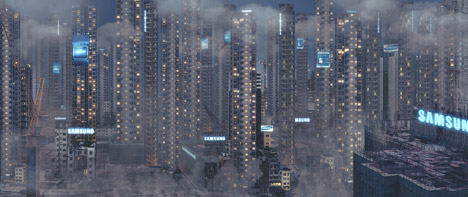
An accompanying soundtrack produced by electronic musicians Coldcut adds a further ambient dimension to the experience of observing the flickering lights and shifting fog of the films, which are intended to be projected on very large scale so the viewer has to move around to see everything.
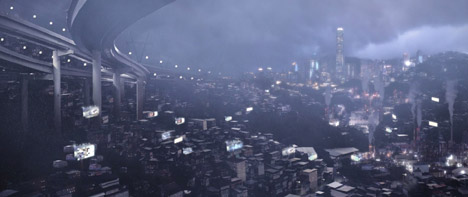
"Each animation is loaded with detail so as each time it is watched you might discover something different," Young added. "The scale of the projections mean you are able to fully immerse yourself in the imaginary city, and consumed by the soundscape you can sit and read the short story set in the city."
The panoramic format was chosen to give the animations a sense of scope and realism, as being viewed from "the top of a hill, or a winding mountain road where you can look out over the city unfolding below you."
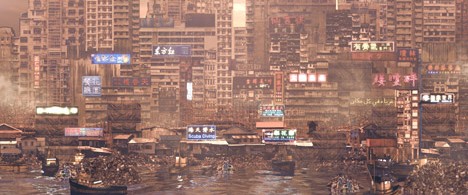
"Most cities offer this romantic overview," explained Young, "a spot to make out, sit on the hood of your car, have a drink. This type of vantage point is where we get a sense of our cities. It was important to reference this sort of panoramic relationship to urban form."
The animations were shown from October 2014 to January this year at the Z33 contemporary art gallery in Hasselt, Belgium, as part of an exhibition titled Future Fiction, which explored different tools and methods for thinking about and visualising the future.
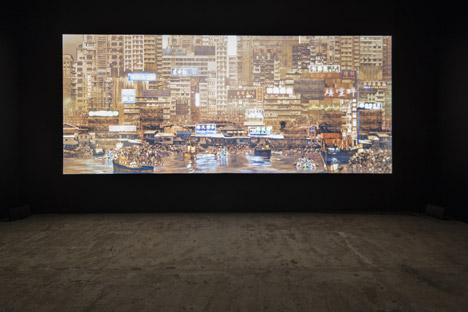
Young wants to collaborate with more science fiction authors to develop the New City project into a much larger collection of animations that will broaden our understanding of the systems and technologies that define today's cities.
Here are descriptions of the three cities from Young:
Samsung city
Samsung city is stitched together from photos of the residential developments seen on expeditions in Korea and Hong Kong, where Samsung have branched out from technology products to move into property development. We see a town where tech brands have become so big that they enter into all aspects of our lives, and brand allegiances shape a new form of patriotism.
Edgelands
Edgelands is based on an expedition through the built infrastructure of the internet, following the fibre optic cable of America’s network to Prineville, Oregon, a town exploiting cheap energy and tax incentives, where Facebook, Amazon, Google and Apple have built massive data centres. This part of New City is built for machines, it is the physical landscape of the cloud, our generation's cultural landscape.
The City in the Sea
The City in the Sea is a multicultural city collaged from photos taken on expeditions through the outsourcing territories of India and China. The floating corporate city is built on the Pacific Ocean garbage patch and drifts in international waters, outside of national labour laws to become a free trade zone supporting the mega companies based on land.